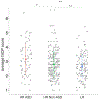Sleep Onset Problems and Subcortical Development in Infants Later Diagnosed With Autism Spectrum Disorder
- PMID: 32375538
- PMCID: PMC7519575
- DOI: 10.1176/appi.ajp.2019.19060666
Sleep Onset Problems and Subcortical Development in Infants Later Diagnosed With Autism Spectrum Disorder
Abstract
Objective: Sleep patterns in children with autism spectrum disorder (ASD) appear to diverge from typical development in the second or third year of life. Little is known, however, about the occurrence of sleep problems in infants who later develop ASD and possible effects on early brain development. In a longitudinal neuroimaging study of infants at familial high or low risk for ASD, parent-reported sleep onset problems were examined in relation to subcortical brain volumes in the first 2 years of life.
Methods: A total of 432 infants were included across three study groups: infants at high risk who developed ASD (N=71), infants at high risk who did not develop ASD (N=234), and infants at low risk (N=127). Sleep onset problem scores (derived from an infant temperament measure) were evaluated in relation to longitudinal high-resolution T1 and T2 structural imaging data acquired at 6, 12, and 24 months of age.
Results: Sleep onset problems were more common at 6-12 months among infants who later developed ASD. Infant sleep onset problems were related to hippocampal volume trajectories from 6 to 24 months only for infants at high risk who developed ASD. Brain-sleep relationships were specific to the hippocampus; no significant relationships were found with volume trajectories of other subcortical structures examined (the amygdala, caudate, globus pallidus, putamen, and thalamus).
Conclusions: These findings provide initial evidence that sleep onset problems in the first year of life precede ASD diagnosis and are associated with altered neurodevelopmental trajectories in infants at high familial risk who go on to develop ASD. If replicated, these findings could provide new insights into a potential role of sleep difficulties in the development of ASD.
Keywords: Autism Spectrum Disorder; Infants; Sleep Problems. Development.
Figures



References
-
- Iglowstein I, Jenni OG, Molinari L, Largo RH: Sleep duration from infancy to adolescence: reference values and generational trends. Pediatrics 2003; 111:302–307 - PubMed
-
- Bernier A, Carlson SM, Bordeleau S, Carrier J: Relations between physiological and cognitive regulatory systems: infant sleep regulation and subsequent executive functioning. Child Dev 2010; 81:1739–1752 - PubMed
-
- Shaffery JP, Sinton CM, Bissette G, Roffwarg HP, Marks GA: Rapid eye movement sleep deprivation modifies expression of long-term potentiation in visual cortex of immature rats. Neuroscience 2002; 110:431–443 - PubMed
Publication types
MeSH terms
Grants and funding
LinkOut - more resources
Full Text Sources
Medical

